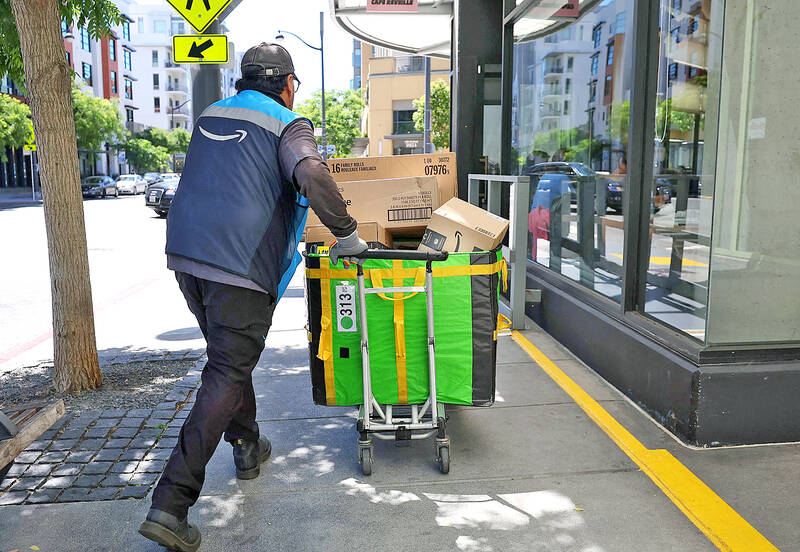After a particularly grueling day delivering packages in 32°C outside of Philadelphia, Pennsylvania, Amazon.com Inc delivery driver Randy woke up feeling off, checked the weather and decided he did not feel safe going into work.
Worried that his boss might punish him by taking away shifts, Randy, who asked to use only his first name for fear of retaliation, lied when he called in sick and said he was seriously ill.
“I wouldn’t say I felt afraid of the heat, but I could tell I wasn’t in a fit state to drive,” he said.

Photo: AFP
With heat waves sweeping across the US, drivers delivering packages for Amazon — the largest package delivery player in the country — are having to work through record-setting temperatures.
In interviews with the Thomson Reuters Foundation, drivers complained of boiling hot vans, insufficient break time and routes that are dangerous to complete amid soaring temperatures.
After Amazon Prime Day on Tuesday and Wednesday, even more packages would need to be delivered following the two-day sale in which the company typically does 1 to 2 percent of its annual business.
The company, the biggest US online retailer, says it has taken measures to keep the drivers delivering its packages safe.
Amazon does not directly employ its drivers, but instead manages the fleet through the Delivery Service Partner (DSP) system, a network of small businesses that contract with Amazon and hire drivers directly.
When thermometers hit 46°C, Amazon’s automated system tells workers to return to their stations and halt work.
In some areas, Amazon has been easing the flow of packages, retrofitting some vans with new air-conditioning (AC), allowing extra breaks, and providing water and electrolytes to drivers — all moves that many said helped take the edge off the brutal heat.
“We have industry-leading heat mitigation programs and technology across our network and many other companies are only now starting to do things we’ve done for years,” Amazon spokesman Steve Kelly said in an e-mail. “While no company is perfect, we work hard to keep our employees and those who deliver on our behalf safe and are proud of the thousands of team members who work together to both prepare for and respond to these unprecedented heat waves.”
However, sometimes, the protective measures are not enough, according to drivers, DSPs and Amazon dispatch workers who spoke to the Thomson Reuters Foundation.
“They send me out into the wild in an oven on wheels,” said James, a driver in New York who recently quit delivering for Amazon and who asked that his full name be withheld for fear of retaliation. “It can be scary.”
Ahead of Prime Day, about 130 million people, or about 39 percent of the US population, were living under some form of heat alert as climate change fuels extreme weather. Seventy-nine counties were under an extreme heat warning.
Matt Kaze, a former driver who helps operate a DSP in California, said that Amazon has “really stepped it up” during this year’s heat waves, citing initiatives to insulate the inside of vans, and the improvement of AC in his vehicle fleet.
The manager of a DSP partner in Simi Valley, California, said the volume of packages during the heat wave has not let up even though she asked Amazon to reduce the number of deliveries.
Still, she was grateful that Amazon had eased its “engine off compliance” rules, meaning drivers can keep the AC running while they drop off a package.
Even so, a driver at her station developed heatstroke last month.
“Our drivers are struggling,” the manager said, speaking on condition of anonymity for fear of business consequences.
Multiple drivers said that they felt that slowing down or taking too many breaks would affect the routes they might get assigned, or maybe lead to them being fired.
Kelly said that Amazon gave drivers special gear to help cope with the heat, including sunscreen, electrolyte powder and “cooling bandanas.”
“If at any point a delivery associate begins to feel unwell, they are instructed to return to their station,” he said.
Last year, Amazon had reduced routes by more than 96.9 million minutes across the US to allow for more break time during the heat, he said.
Experts say that staying safe in the heat is quite simple: People need to work slower, take more breaks and spend time in the shade.
“It’s not super complicated — we all know when we are outside jogging and it’s too hot, we slow down, and if it’s really hot, we sit down, and if it’s too hot, we go inside and turn on the AC,” said Juley Fulcher, the worker health and safety advocate at Public Citizen, a US public interest and consumer advocacy group. “But that’s not always possible for an Amazon driver.”
Amazon disputes this, saying that drivers are always free to stop if they feel unsafe in the heat.
Last year, a group of Amazon drivers in California formed a union in part due to concerns about heat safety on the job.
There is no federal standard for protecting workers from heat, although there is a general duty to keep employees safe on the job.
US President Joe Biden’s administration this month proposed a set of heat standards, but it could take years before the proposals are actually adopted, former US Occupational Safety and Health Administration deputy assistant secretary of labor Jordan Barab said.
Many of the rules mandate practices Amazon already says it has in place, such as increasing access to breaks as the heat index rises, and providing training on heat safety.
In practice, employers such as Amazon delivery partners are likely to fly under the radar of regulators, Barab said.
“Unless an employee is killed, you are not likely to see an inspector,” he said.
In the meantime, with temperatures climbing to more than 38°C in many parts of the US, drivers make every effort to stay cool.
“I keep my hair wet all day,” Randy said. “I am always asking people to hose me down.”

Leading Taiwanese bicycle brands Giant Manufacturing Co (巨大機械) and Merida Industry Co (美利達工業) on Sunday said that they have adopted measures to mitigate the impact of the tariff policies of US President Donald Trump’s administration. The US announced at the beginning of this month that it would impose a 20 percent tariff on imported goods made in Taiwan, effective on Thursday last week. The tariff would be added to other pre-existing most-favored-nation duties and industry-specific trade remedy levy, which would bring the overall tariff on Taiwan-made bicycles to between 25.5 percent and 31 percent. However, Giant did not seem too perturbed by the

AI SERVER DEMAND: ‘Overall industry demand continues to outpace supply and we are expanding capacity to meet it,’ the company’s chief executive officer said Hon Hai Precision Industry Co (鴻海精密) yesterday reported that net profit last quarter rose 27 percent from the same quarter last year on the back of demand for cloud services and high-performance computing products. Net profit surged to NT$44.36 billion (US$1.48 billion) from NT$35.04 billion a year earlier. On a quarterly basis, net profit grew 5 percent from NT$42.1 billion. Earnings per share expanded to NT$3.19 from NT$2.53 a year earlier and NT$3.03 in the first quarter. However, a sharp appreciation of the New Taiwan dollar since early May has weighed on the company’s performance, Hon Hai chief financial officer David Huang (黃德才)

NVIDIA FACTOR: Shipments of AI servers powered by GB300 chips would undergo pilot runs this quarter, with small shipments possibly starting next quarter, it said Quanta Computer Inc (廣達), which supplies artificial intelligence (AI) servers powered by Nvidia Corp chips, yesterday said that AI servers are on track to account for 70 percent of its total server revenue this year, thanks to improved yield rates and a better learning curve for Nvidia’s GB300 chip-based servers. AI servers accounted for more than 60 percent of its total server revenue in the first half of this year, Quanta chief financial officer Elton Yang (楊俊烈) told an online conference. The company’s latest production learning curve of the AI servers powered by Nvidia’s GB200 chips has improved after overcoming key component

UNPRECEDENTED DEAL: The arrangement which also includes AMD risks invalidating the national security rationale for US export controls, an expert said Nvidia Corp and Advanced Micro Devices Inc (AMD) have agreed to pay 15 percent of their revenue from Chinese artificial intelligence (AI) chip sales to the US government in a deal to secure export licenses, an unusual arrangement that might unnerve both US companies and Beijing. Nvidia plans to share 15 percent of the revenue from sales of its H20 AI accelerator in China, a person familiar with the matter said. AMD is to deliver the same share from MI308 revenue, the person added, asking for anonymity to discuss internal deliberations. The arrangement reflects US President Donald Trump’s consistent effort to engineer